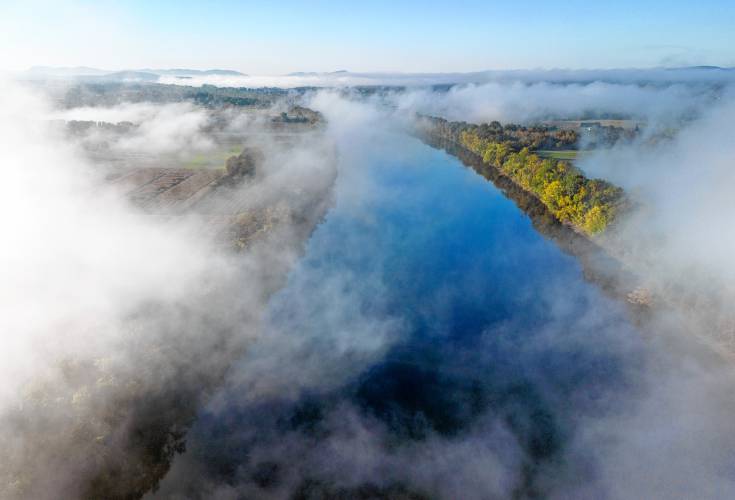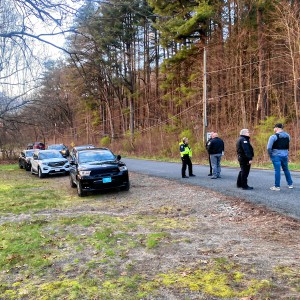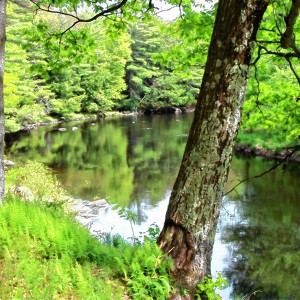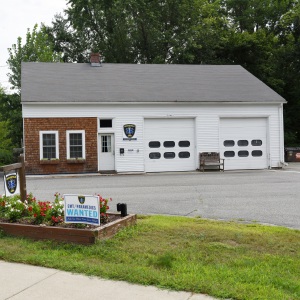My Turn: Time to retire Northfield Mountain Pumped Storage Station

Fog rolls through across the valley over the Connecticut River in the early morning in Sunderland. STAFF FILE PHOTO/DAN LITTLE
| Published: 03-13-2024 6:00 PM |
I’m not a fisherman, but I love rivers. Rivers carry the rain and snow water back to the sea where it will be picked up by the sun again and delivered somewhere else in an endless hydrologic cycle.
Almost magic! Easily elegant and awe-inspiring! A healthy waterway is clean and full of life. Something for which to be grateful and to protect.
Our local stretch of the Connecticut River used to flourish with salmon, alewives, shad and other anadromous fish on their spawning runs when our streams flowed freely. What a beautiful spectacle that thrashing about must have been! And could possibly be again.
These days, electricity generating facilities in our area interact with the river and are currently in a review process before probable relicensing for a period of 40-50 years. I’m going to focus here on the Northfield Mountain Pumped Storage Station, which affects a 26-mile length of the Connecticut River.
What an engineering marvel this pumped storage project must have been! Imagine: capturing otherwise wasted electric generating capacity at night for later release by powering giant turbines to push, at 15,000 cubic feet per SECOND, as much water as a football field-size pool 1½ MILES deep, up to a mountaintop reservoir.
Later, it would reclaim two-thirds of that energy when the stored water poured back down through the turbines, at 20,000 cf/second, creating juice for sale in peak demand daylight hours. How clever! But wait — there was a major flaw in the design. Along with the vast amount of river water came the fish: eggs, larva, minnows, as well as caddis and mayflies and other aquatic life. The turbines pulverized it indiscriminately. It must have clouded the water and left body parts on riverbanks, everywhere. Year after year. Continuing now.
The force of the flow in both directions, pump up and release down, was and is, so powerful that it causes the river to flow backward at times. For miles.
Could the biological mayhem have been avoided with a very large dedicated water storage pool, isolated from the river at a low elevation, so that the pump up and fall down cycled between the upper and lower pools and did not involve the river or aquatic life at all? Probably yes, but presumably at astronomical monetary cost. A nonstarter. And who was going to represent the interests of the fish?
Article continues after...
Yesterday's Most Read Articles
 Authorities ID victim in Greenfield slaying
Authorities ID victim in Greenfield slaying
 State records show Northfield EMS chief’s paramedic license suspended over failure to transport infant
State records show Northfield EMS chief’s paramedic license suspended over failure to transport infant
 Police report details grisly crime scene in Greenfield
Police report details grisly crime scene in Greenfield
 On The Ridge with Joe Judd: What time should you turkey hunt?
On The Ridge with Joe Judd: What time should you turkey hunt?
 ‘I have found great happiness’: The Rev. Timothy Campoli marks 50 years as Catholic priest
‘I have found great happiness’: The Rev. Timothy Campoli marks 50 years as Catholic priest
 Formed 25,000 years ago, Millers River a historic ‘jewel’
Formed 25,000 years ago, Millers River a historic ‘jewel’
Think, too, of the times. This plant came on line in tandem with Vermont Yankee, so that it could use the juice Vermont Yankee would be generating at night to pump the reservoir full. Also, in 1972, the Clean Water Act became law. The Connecticut River had long been a dumping place for industrial pollution.
I can remember as a child, crossing the White Bridge from Greenfield to visit grandparents on Montague City Road. As soon as the car rounded the sharp corner onto the bridge, there, in plain view, was Esleeck Paper with colored liquid dropping from a factory pipe into the river below.
The dye of the day? How absurd! Were we unable to feel the travesty of a broken connection with beauty and vibrant life force? Had we forgotten what a river is: majestic, poetry in motion, sustainer of life?
The Clean Water Act, at last, has gradually made a noticeable and welcome improvement in the river’s water quality. We’re cleaning up the Connecticut River and advocating for improved, effective fish ladders so that spawning fish can swim upstream around the numerous dams. This is work well worth doing.
At the same time, river life is being ground up in the powerful turbines at Northfield Mountain Pumped Storage Station. I suggest we end this destruction.
Another thought: If filtration or screening were posed as a solution to the problem of river life being ground up in the turbines, my layman’s engineer sense says that any filter with a fine enough mesh to keep biota out would have no chance of allowing enough water into the turbines. Those machines want water fast: 15,000 cubic feet per second.
The relicensing process is underway. The Federal Energy Regulatory Commission (FERC) is the agency in charge and is accepting written comments until April 22.
Vermont Yankee is closed, no more of its juice to harness. Relicensing is now. Let’s retire Northfield Mountain Pumped Storage Station. Let’s restore the fish.
John H. Thompson lives in Greenfield.

 My Turn: A ruthless strategy that damages US
My Turn: A ruthless strategy that damages US Analee Wulfkuhle: Shores Ness a vote for Deerfield’s future
Analee Wulfkuhle: Shores Ness a vote for Deerfield’s future Byron Coley: Shores Ness for Select Board
Byron Coley: Shores Ness for Select Board Amy Tibbetts: Northfield residents deserve truth and clarity
Amy Tibbetts: Northfield residents deserve truth and clarity
